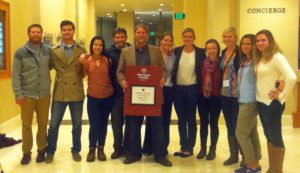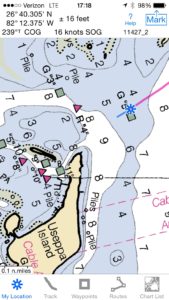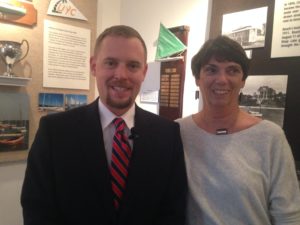January was a busy month for the St. Augustine Lighthouse & Museum’s Lighthouse Archaeological Maritime Program (LAMP).
When many people envision our work they think of our field season. Diving, marine survey, and working on boats is all we do, right? Not quite!
For every hour we spend in the field, we spend another seven to ten hours working in the lab to accomplish our mission. The fall, winter, and spring are usually spent organizing and analyzing data from the field, working with artifacts recovered from our excavations, and poring over historical documents that shed light on the research questions we develop. In addition, a great amount of time is consumed simply covering the bases of operating grant requirements, developing budgets for upcoming work, applying for grants, and making sure our research is disseminated to the public.
We have several public audiences, ranging from fellow scholars in the field, school groups, community organizations, and, of course, the visitors to the lighthouse museum.

Chuck Meide, LAMP Director, holds a session sign from the Society for Historical Archaeology conference in Seattle, January 2015. He is flanked by past students and supervisors of the LAMP field school program.
Chuck Meide, director of the LAMP program, travelled to Seattle during early January to the Society for Historical Archaeology (SHA) national conference. Every year LAMP maintains a presence at the conference to both present on our most recent research as well as to advertise our annual field school in underwater archaeology.
This year, Chuck presented on our most recent survey project to find the Lost French Fleet of 1565. This project is a NOAA Ocean Explorer‘s signature exploration and also funded by the State of Florida.
Since 2007, there has been a growing number of our former students and supervisors in attendance at SHA. This year, eleven conference attendees represented LAMP’s work over the past eight years, not a bad turnout!
Keep in mind too, that almost 100% of these folks were there as currently employed archaeologists in the field or as graduate students preparing for a profession in archaeology.

Not many presentations require a boat ride to get to the location but this one did. I screencaptured my phone while on the ride to the island!
January also found me on the road, but on Florida’s other coast, not the continent’s ‘other’ coast.
On January 10th, I presented a talk called ‘Florida’s Fleet’ at the Barbara Sumwalt Historical Museum on Useppa Island. Useppa is a gem on Florida’s Gulf Coast and is a privately-owned island near Ft. Myers.
My gracious host, Rona Stage, put me up in the wonderful Collier Inn. Rona is director of the island’s historical society and provided a wonderful historical tour of the island.
The Collier Inn, among its other interested chapters in history, served as the planning center for the Bay of Pigs Invasion in 1960. Earlier in life, the building was the private home to Barron Collier, for which Collier County is named. During the early 20th century Useppa Island was known as the ‘Land of the Silver King’.
Wealthy fishermen came from all over the world to fish for tarpon in the clear waters Redfish Pass. Much of that has not changed and the island still sits in some majorly fishy waters.
Alas, I was not there to catch fish but to talk about one of the largest fishing fleets ever assembled, the commercial fishing trawlers built in St. Augustine during the 20th century.
Last year, I joined the Florida Humanities Council Speakers Bureau and have traveled around the state telling people why boatbuilding in St. Augustine is one of Florida’s most important and interesting chapters of history.
This particular talk was not part of the Speaker’s Bureau presentations but falls in line with other presentations I give and they often select their speakers from the Bureau’s ‘menu.’ With each talk, I always meet inspiring people, many of whom have personal stories and connections to the shrimp fishery and/or trawler-building industry.

Brendan Burke (me), LAMP Archaeologist with Rona Stage, Director of the Useppa Island Historical Society in the Barbara Sumwalt Historical Museum.
Since August of 2011, LAMP outreach has totaled over 11,350 attendees, over 300 people every month. Through teaching, lectures here, lectures on the road, educational tables at events, and events here at the lighthouse our job is to get the word out about what we do.
Visit our events calendar to see upcoming events. We have lots of opportunities for people to learn about what we do.
If you haven’t visited with us, please do. We want to share with you exciting discoveries we are making here at the St. Augustine Lighthouse & Museum!
Brendan Burke joined the St. Augustine Lighthouse & Maritime Museum in 2007 as an archaeologist for the Lighthouse Archaeological Maritime Program. He holds a graduate degree in Anthropology from the College of William & Mary.

